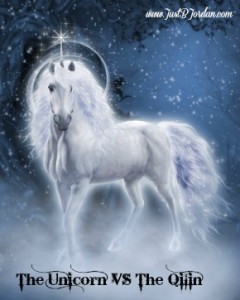The Unicorn VS The Qilin
Descriptions of the unicorn and the qilin have become more and more alike as the years pass. They began as two separate, though slightly similar, legends. The unicorn came to life in Western beliefs while the qilin was born to Eastern culture.
Let’s take a look at the roots of both the unicorn and the qilin, and at the more recent changes to their seemingly merging image.
The Unicorn
The original unicorn has the body of a goat-like horse, the head of a deer, the tail of a boar, cloven hooves, and a single horn of roughly 27″ long which is either entirely black or colored in white, red, and black. It is not uncommon for a unicorn to have the beard of a goat growing on its chin. Its voice is loud and bellowing.
Dust filed from their horns can make poison potable, as will using a unicorn’s horn as a cup. Their horns can also cure sickness.
The unicorn is an extremely wild woodland creature; both fearsome, strong, and impossible to tame. Yet it is an animal of purity and grace. A unicorn can only be caught by one of pure heart. It will willingly come and lay its head in the lap of a sleeping girl.
Unicorns were often depicted wearing a collar with a broken chain hanging from it. This symbolized that imprisoning such a fearsome and independent creature was impossible.
The Qilin
The Chinese qilin has a deer-like body, cloven hooves, and are often quite large. They usually share several traits with the eastern dragon: their eyelashes, puffy manes, scaled bodies, and the shape of their heads. Quilin’s typically have dragon or deer-like antlers and not the single horn of a unicorn. The most common color of a qilin is gold, though they are known to exist in practically every color, such as earthen tones, the color of precious metals and gems, and even the elements.
A qilin’s voice is like the sound of bells or chimes. Qilin’s are frequently depicted with fire at its feet or around parts of its body. They can even spout flames from their mouths, and were sometimes believed to be the sacred pets of deities.
The qilin may look formidable and intimidating, but they are gentle and of quiet nature. They will become ferocious if a pure person is in danger from a wicked one.
Qilin’s show themselves at the imminent succession or death of a distinguished ruler. They also appear to particularly compassionate or wise persons.
Qilin’s are thought to be a good omen, bringing serenity, success, protection, longevity, or fertility to those they show themselves to.
Conclusion
 The Western unicorn slowly changed image over recent decades. It is no longer the assertively wild, goat-like creature of predominantly black as it once was. Unicorns are now commonly portrayed as a majestic white horse. All that remains of their original form is the single horn and their draw to purity. They have become known as a gentle and mystic creature, as the qilin have always been.
The Western unicorn slowly changed image over recent decades. It is no longer the assertively wild, goat-like creature of predominantly black as it once was. Unicorns are now commonly portrayed as a majestic white horse. All that remains of their original form is the single horn and their draw to purity. They have become known as a gentle and mystic creature, as the qilin have always been.
Many depictions of the qilin have also had a shift of appearance over recent years. They shrunk to the size of a deer and lost nearly all of their dragon-like attributes. They are now typically seen as being white, as the unicorn is. If you saw a recent drawing of the qilin you would likely believe it was an older version of the unicorn.
What do you think of the unicorn and the qilin, and of the change in their images?
Fun Facts
Horns of narwhals were once sold as unicorn horns.
From the descriptions in long-ago claims of having seen a unicorn(such as Marco Pollo’s), it is clear that what people actually saw was a rhinoceros.
In the Ming Dynasty, Zhen He’s fleet transported giraffes back to China from East Africa. They believed the giraffes were qilin’s due to their similarity, i.e. their gentle nature, tall body, scale-patterned coats, and the ossicones on their heads.
The Korean word for qilin is girin. In modern Korean it simply means giraffe.
Just B. Jordan is an award-winning author of fantasy and sci-fi. She graduated high school a year early and received her first publishing contract at the age of 18. To Ashes We Run is her most recent novel. Find it here.

The Mythology of Ice Fantasy, Part 2 – Illuminating the Fool's Mirror
[…] Jordan, Just B., “The Unicorn VS the Qilin,” Just B. Jordan, accessed Dec. 26, 2020, https://justbjordan.com/2015/01/unicorn-vs-qilin/. […]